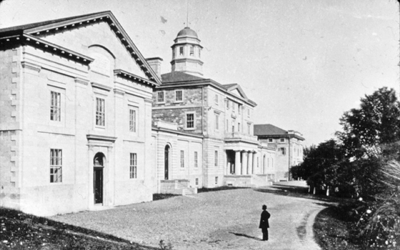Convocation Ceremony Archive
Welcome to our video archive of past convocations. A live webcast of each ceremony will be available on the date of convocation.
Past Ceremonies
Fall Convocation 2021 - Ceremony 1
Fall Convocation 2021 - Ceremony 2
Fall Convocation 2021 - Ceremony 3
Fall Convocation 2021 - Ceremony 4
Spring Convocation 2021
Fall Convocation 2020
Spring Convocation 2020
Fall Convocation 2019 - AM Ceremony
Fall Convocation 2019 - PM Ceremony
Spring Convocation 2019
Fall Convocation 2018 - AM Ceremony
Fall Convocation 2018 - PM Ceremony
Spring Convocation 2018
Astronaut Drew Feustel's Message to Science Class of 2018
Fall Convocation 2017
Spring Convocation 2017
Fall Convocation 2016
Spring Convocation 2016
Past Ceremonies (2015 and earlier)
To view ceremonies from 2015 and earlier on bCoolTV, please ensure you have Microsoft Silverlight plug-in enabled on your browser.
- Webcast lets you watch the video on-line directly from your web browser.
- WMV video file can be downloaded and viewed on computers with a video player.
- MP4 video file can be downloaded and viewed on computers with a video player.
- MP3 audio file can be downloaded and played on computers with audio capability.
Fall Convocation 2015
Spring Convocation 2015
Spring and Fall Convocation 2014
Spring and Fall Convocation 2013
Spring and Fall Convocation 2012
Spring and Fall Convocation 2011
Spring and Fall Convocation 2010
Spring and Fall Convocation 2009
The Origin of Modern Universities
 Although a famous medical school existed in Salerno from the ninth century, the first true university was founded at Bologna in the 11th century. It became a widely respected school of canon and civil law. The first university in northern Europe came into existence between 1150 and 1170; the Université de Paris was particularly noted for instruction in theology and served as a model for many other schools, including Oxford, which was well established at the end of the 12th century. The purpose, organization, and system of internal governance of today’s universities can be traced back to these earliest institutions. Many of our university rituals reflect this rich heritage.
Although a famous medical school existed in Salerno from the ninth century, the first true university was founded at Bologna in the 11th century. It became a widely respected school of canon and civil law. The first university in northern Europe came into existence between 1150 and 1170; the Université de Paris was particularly noted for instruction in theology and served as a model for many other schools, including Oxford, which was well established at the end of the 12th century. The purpose, organization, and system of internal governance of today’s universities can be traced back to these earliest institutions. Many of our university rituals reflect this rich heritage.
Academic Degrees
The university was probably modelled on the medieval trade guilds. To be granted the master’s degree meant that one had attained the level of competence needed to become a member of the guild and could commence to do its work (hence the use of the term “commencement” to describe ceremonies at the end of the academic year). The work of the master of arts was to teach. The doctor was one who, having been accepted into the guild through attainment of mastership, had successfully completed the curriculum of one of the higher faculties (these being, in the Middle Ages, theology, medicine, and law) and was now qualified to teach in those faculties. “Doctor” is, in fact, the Latin for teacher. The term “bachelor,” which originally denoted the assistant to a small landowner, in the Middle Ages came to mean an apprentice as opposed to a master workman.
The Academic Assembly
Convocation is the modern equivalent of the medieval magna congregatio of all faculties. The academic procession, which is such a colourful part of convocation, harks back to the procession of the guild of teachers. Today, as has been the practice for centuries, the faculties present to the chancellor the graduating students and indicate the degree of proficiency that the students have attained.
Origins of Academic Regalia
Academic Regalia
Academic regalia derives from the apparel worn when the first universities were founded. The two types of academic cap, the square one, called a biretta, and the round cap, called a pileus, derive from the normal headwear of the Middle Ages. The origin of the Oxford (or mortar board) cap with stiff corners is unknown, some saying that it derives from the master mason’s mortar board, others that it symbolizes the quadrangular shape of the school’s campus, still others that it echoes the shape of a book. It is not known when “capping” became part of the ceremony of receiving the academic degree. Under Roman law, a slave was freed by being allowed to put on a cap; it is thought that the cap of the Oxford MA indicated the scholar’s independence.
Cloaks, worn in the Middle Ages over articles of dress much as we wear a coat, usually had an attached hood which could be pulled up over the head. The hood first appeared as a separate article of attire in the 13th century. Over time, the English universities began to prescribe by university statute the details of the scholars’ apparel to distinguish the different faculties and the different degrees of learning. The colours of the hood linings were particularly useful in this respect. In keeping with a very ancient tradition, McGill University has also regulated its academic dress.
McGill University's Academic Regalia
 Doctors of Philosophy wear scarlet robes and scarlet hoods lined with pale green. Those who have earned other doctoral degrees wear black robes and scarlet hoods lined with the distinctive colour of their degree. Masters wear black robes and black hoods lined with the distinctive colour of their degree, as do the bachelors; however, the hoods of bachelors are bordered with white. Certificate and diploma recipients wear black gowns; if they have previously obtained a degree, they wear the hood of that degree.
Doctors of Philosophy wear scarlet robes and scarlet hoods lined with pale green. Those who have earned other doctoral degrees wear black robes and scarlet hoods lined with the distinctive colour of their degree. Masters wear black robes and black hoods lined with the distinctive colour of their degree, as do the bachelors; however, the hoods of bachelors are bordered with white. Certificate and diploma recipients wear black gowns; if they have previously obtained a degree, they wear the hood of that degree.
On March 23, 2011, McGill University’s Senate approved the adoption of graduation scarves to be worn with academic regalia by First Nations, Inuit, and Métis students who have successfully completed their programs of study. The scarf for a degree recipient is red, for McGill; the feather “signifies high respect of a person and marks an amazing special event”; the Confederacy Belt signifies “the land we are on” (Iroquois). The scarf for a certificate or diploma graduate is white and includes the eagle feather and the turtle, a symbol to represent all the original people of North America. The McGill crest at the nape of the scarf links the University to our Aboriginal graduates and signifies our connection to their achievements.
In addition, Indigenous students crossing the stage who wish to wear their traditional Indigenous regalia instead of the gown are welcome to do so. They are encouraged to wear or carry their hood, the colour of which corresponds to the academic degree earned, as a symbol recognizing their entry into a community of scholars.
Faculties and Colours
The colours of the hood linings are the following:
- Doctor of Civil Law, D.CL. - grey
- Doctor of Dental Medicine, D.MD. - pink
- Doctor of Medicine and Master of Surgery, M.D.,C.M. - dark blue
- Doctor of Music, D.Mus. - mauve
- Doctor of Philosophy, Ph.D. - pale green
- Master of Architecture, M.Arch. - white
- Master of Arts, M.A. - pale blue
- Master of Business Administration, M.B.A. - purple
- Master of Civil Law, M.CL. - grey
- Master of Education, M.Ed. - peacock blue
- Master of Engineering, M.Eng. - scarlet
- Master of Information Studies, M.ISt. - orange
- Master of Laws, LL.M. - grey, front strap braided with green
- Master of Management, M.M. - gold
- Master of Music, M.Mus. - mauve
- Master of Public Policy - cranberry
- Master of Sacred Theology, S.T.M. - blue purple
- Master of Science, M.Sc. - yellow
- Master of Science, Applied, M.Sc.A. - yellow and pale green
- Master of Social Work, M.S.W. - fuchsia
- Master of Urban Planning, M.UP. - bright green and dark blue
- Bachelor of Arts, B.A. - pale blue
- Bachelor of Arts and Science, B.A.&S.c. - yellow and pale blue
- Bachelor of Arts (Education) - peacock blue and pale blue
- Bachelor of Civil Law, B.CL. - grey
- Bachelor of Commerce, B.Com. - purple
- Bachelor of Education, B.Ed. - peacock blue
- Bachelor of Engineering, B.Eng. - scarlet
- Bachelor of Software Engineering, B.SE. - scarlet and yellow
- Bachelor of Laws, LL.B. - grey, front strap braided with green
- Bachelor of Laws and Bachelor of Civil Law, LL.B./B.CL. - grey, front strap braided with red above, green below
- Bachelor of Music, B.Mus. - mauve
- Bachelor of Nursing, B.N. - dark blue
- Bachelor of Science, B.Sc. - yellow
- Bachelor of Science (Agricultural and Environmental Sciences), B.Sc.(AES.) - dark green
- Bachelor of Science (Agricultural Engineering), B.Sc.(AgrEng.) - dark green and scarlet
- Bachelor of Science (Architecture), B.Sc.(Arch.) - yellow and white
- Bachelor of Science (Food Science), B.Sc.(FSc.) - jade green
- Bachelor of Science (Kinesiology), B.Sc.(Kin.) - coral
- Bachelor of Science (Nursing), B.Sc.(N.) - dark blue and scarlet
- Bachelor of Science (Nutritional Sciences), B.Sc.(Nutr.Sc.) - beige and dark blue
- Bachelor of Science (Rehabilitation Science), B.Sc.(Rehab.Sci.) - dark blue and yellow
- Bachelor of Social Work, B.SW. - fuchsia
- Bachelor of Theology, B.Th. - blue purple
